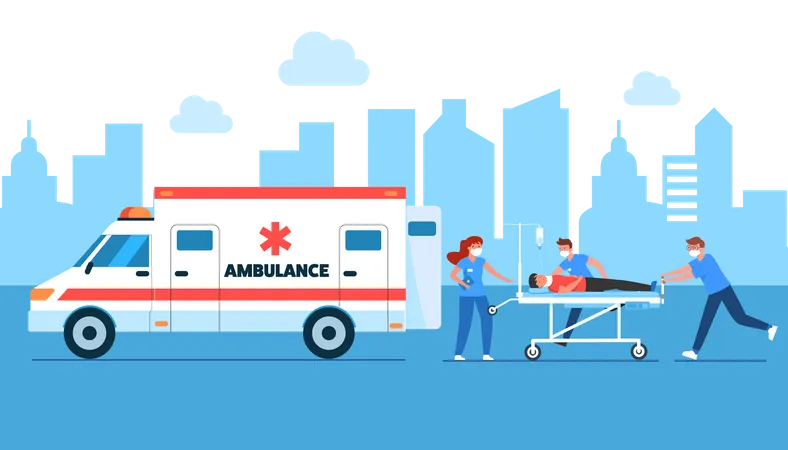In the realm of emergency response, time is of the essence. Every second can make a difference between life and death. In recent years, technology has emerged as a crucial ally in optimizing emergency medical services (EMS) and ambulance dispatch systems. One of the most significant advancements in this field is the development of ambulance apps, which aim to streamline the process of requesting and dispatching ambulances, thereby saving precious time and improving patient outcomes.
The Evolution of Emergency Response
Before delving into the intricacies of ambulance app development, it's essential to understand the challenges that traditional emergency response systems face. Historically, emergency calls were routed through centralized dispatch centers, where operators manually processed incoming calls and dispatched ambulances based on predefined protocols and geographic locations. While effective to some extent, this system had its limitations, including delays in dispatching, inefficient resource allocation, and lack of real-time communication between stakeholders.
The Emergence of Ambulance Apps
The advent of smartphone technology and ubiquitous internet connectivity paved the way for a new era in emergency response. Ambulance apps leverage these advancements to provide a more efficient and responsive system for requesting and dispatching ambulances. These apps typically allow users to request emergency assistance with the tap of a button, automatically transmitting their location and relevant medical information to dispatchers.
Key Features of Ambulance Apps
Ambulance apps are designed to be user-friendly and intuitive, ensuring that anyone, regardless of their technical expertise, can easily request emergency assistance when needed. Some key features commonly found in ambulance apps include:
One-Touch Emergency Button: A prominent button on the app's interface allows users to quickly summon help in case of an emergency.
GPS Location Tracking: The app automatically detects the user's location using GPS technology, ensuring that dispatchers can accurately pinpoint the caller's whereabouts.
Medical Profile Integration: Users can create and store their medical profiles within the app, including vital information such as allergies, pre-existing conditions, and emergency contacts. This information is transmitted to dispatchers to help first responders better understand the caller's medical needs.
Real-Time Communication: Ambulance apps facilitate real-time communication between users, dispatchers, and first responders, enabling swift coordination and updates throughout the emergency response process.
Feedback and Rating System: After the emergency is resolved, users can provide feedback and ratings on the quality of service received, helping to improve the system's efficiency and effectiveness over time.
Challenges and Considerations
While ambulance apps offer tremendous potential for improving emergency response systems, their development and implementation come with certain challenges and considerations:
Data Privacy and Security: Ambulance apps handle sensitive personal and medical information, making data privacy and security paramount concerns. Developers must implement robust encryption and authentication mechanisms to safeguard user data against unauthorized access.
Integration with Existing Systems: Ambulance apps need to seamlessly integrate with existing EMS infrastructure, including dispatch centers, ambulance fleets, and healthcare facilities. Compatibility issues and interoperability challenges may arise during the integration process and must be addressed proactively.
Accessibility and Equity: Ensuring equitable access to ambulance services is essential, particularly in underserved communities where smartphone penetration may be lower. Ambulance apps should be designed with accessibility features and alternative communication channels to cater to diverse user demographics.
Regulatory Compliance: Ambulance apps must comply with regulatory standards and guidelines governing emergency medical services, including HIPAA (Health Insurance Portability and Accountability Act) regulations for protecting patient confidentiality.
Case Studies: Success Stories in Ambulance App Development
Several cities and regions worldwide have successfully implemented ambulance apps, yielding tangible improvements in emergency response times and patient outcomes. For example:
United States: Cities like Los Angeles and Washington, D.C., have deployed ambulance apps that integrate with their 911 dispatch systems, allowing residents to request emergency assistance directly from their smartphones. These apps have helped reduce response times and improve the efficiency of EMS operations.
Europe: Countries like the United Kingdom and Germany have implemented nationwide ambulance app initiatives, enabling citizens to access emergency services regardless of their location. These apps incorporate advanced features such as automated defibrillator locators and CPR instructions to empower bystanders to assist in medical emergencies.
The Future of Ambulance App Development
As technology continues to evolve, the future of ambulance app development holds exciting possibilities. Some potential areas of innovation and advancement include:
AI-Powered Triage: Integrating artificial intelligence (AI) algorithms into ambulance apps to perform real-time triage and prioritize emergency calls based on the severity of the situation and available resources.
Wearable Devices: Leveraging wearable devices such as smartwatches and health trackers to monitor users' vital signs and automatically trigger emergency alerts in case of medical emergencies.
Drone Integration: Exploring the use of drones for rapid response and delivery of medical supplies to remote or inaccessible areas, supplementing traditional ambulance services.
Telemedicine Integration: Integrating telemedicine capabilities into ambulance apps to enable remote consultation between paramedics, emergency physicians, and specialists, enhancing the quality of care delivered in the field.
Conclusion
Ambulance app development represents a significant step forward in optimizing emergency response systems and saving lives. By harnessing the power of technology, these apps empower individuals to access timely and efficient emergency medical services when every second counts. As developers continue to innovate and refine these platforms, the future looks promising for improving emergency healthcare delivery worldwide.








